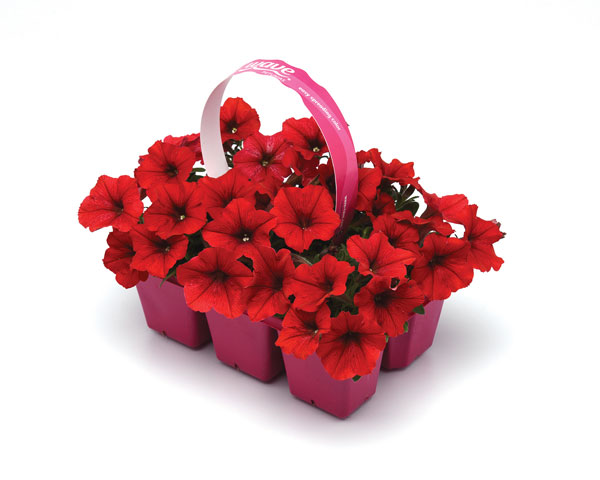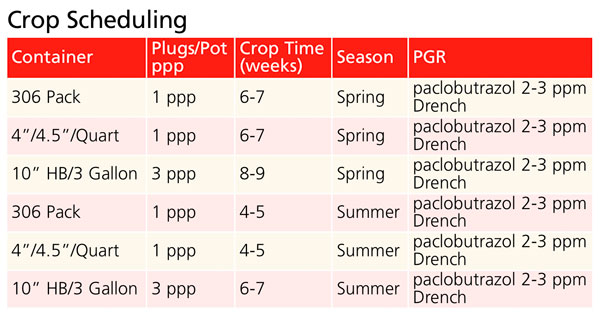9/1/2021
The Evolution of Easy Wave Petunias
Lisa Lacy
E3 Easy Wave is a significant development in Wave Petunia breeding. What do the three E’s mean? Early, Efficient and the Evolution of the well-known and much utilized series, Easy Wave. Each product in this new series can be produced under short days. We selected all varieties in E3 Easy Wave to flower in 10 hours or less. This timing is critical for those early-season, in-market dates or to achieve an early turn for spring holiday foot traffic at retail.
Let’s talk about how E3 is “efficient.” It has a neat, mounded habit in baskets. In 6-packs, plants won’t tangle on the bench. They also hold well. Their dome shape is achieved with a natural compactness, which translates to a half-rate use of PGRs during production compared to the Easy Wave series on nearly all of the E3 colors (see recommendations for E3 Blue below). This improved habit has huge retail appeal—high quality, good sell-through and launches with seven E3 colors.
 Pictured: E3 Easy Wave landscape bed, Week 34, Elburn, Illinois.
Pictured: E3 Easy Wave landscape bed, Week 34, Elburn, Illinois.
The “evolution” comes in because while E3 grows controlled and mounded, the end user will still receive the true Wave Petunia promise of easy, spreading color. They’ll take up about 85% of the space that Easy Wave covers, with more mounding for great coverage in the center of the plants. So growers get the control they need, with a high-impact, quality finish for retail, and gardeners enjoy the extraordinary performance they expect from Wave Petunias.
It’s a great solution to consider for your greenhouse. Here are a few additional production details for E3 Easy Wave:
Plug crop time: 4 to 6 weeks
Transplant to finish:
Spring—6 to 7 weeks
Summer—4 to 5 weeks
Plug culture
E3 Easy Wave is offered as pelleted seed. Sow 1 seed per cell in a 288 or 128 plug size. Seed germinates at 72 to 75F (22 to 24C) and takes three to five days; no need to cover the seed and light is optional. Maintain media pH at 5.5 to 6.0 and EC of 0.75 mmhos/cm during plug production. Keep moisture high at Level 4 to 5.
During Stage 2, provide moisture levels at 3 to 4 with temperatures at 68 to 75F (20 to 24C). Set light at 1,000 to 2,500 f.c. (10,800 to 26,900 Lux). Apply fertilizer less than 100 ppm N, less than 0.7 EC. Decrease moisture slightly to Level 2 to 4 and temperatures to 65 to 70F (18 to 21C) during Stage 3. Light can be increased in this stage to 2,500 to 4,000 f.c. (26,900 to 43,100 Lux). A daminozide/2,500 to 5,000 ppm spray can be applied in Stage 3 as well for early control.
In Stage 4, maintain the same moisture and fertilizer levels as Stage 3 and decrease temperature to 60 to 65F (16 to 18C). Light holds pretty steady at 2,500 to 5,000 f.c. (26,900 to 53,800 Lux). The daminozide rate from Stage 3 can also be applied here for control.
Finishing key tips

Temperatures for finishing:
Day: 61 to 75F (16 to 24C)
Night: 57 to 65F (14 to 18C)
The target media pH should be 5.5 to 6.2 with an EC of 1.5 to 2.0 mmhos/cm. Apply a fertilizer of 225 to 300 ppm N, 1.5 to 2.0 EC.
Daylength notation
These are the minimum daylength requirements by E3 Easy Wave variety:
• 9 hours—White
• 9.5 hours—Coral, Pink, Red, Sky Blue
• 10 hours—Blue, Pink Cosmo
 Post-transplant, E3 Easy Wave varieties (see exceptions) can be controlled with less or half the rate of Easy Wave. North American recommendations:
Post-transplant, E3 Easy Wave varieties (see exceptions) can be controlled with less or half the rate of Easy Wave. North American recommendations:
1. Daminozide spray of 2,500 to 3,000 ppm seven to 10 days after transplant promotes branching and controls early stretch, then:
2. Paclobutrazol 2 to 3 ppm drench seven to 10 days later, additional drenches as needed.
The exception is E3 Easy Wave Blue—use paclobutrazol rates similar to Easy Wave at 5 ppm drench.
All E3 Easy Wave varieties are cold durable. Crop timing is related to average temperature when grown under proper daylength. Plants will take longer to flower when grown in cooler conditions. Recommended DLI range of 12 to 20 mol·m-2·d-1. GT
Lisa Lacy is a portfolio manager for PanAmerican Seed and has been instrumental in managing the Wave Petunia assortment for the company, and is based in Elburn, Illinois. Visit panamseed.com/culture for full GrowerFacts and research documents.